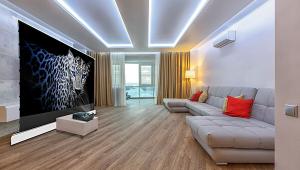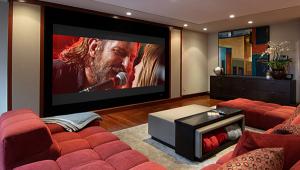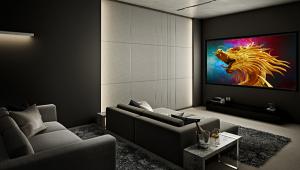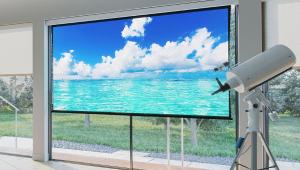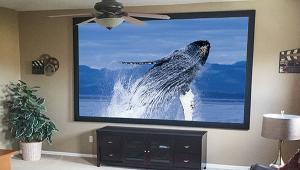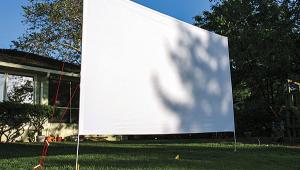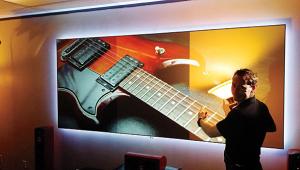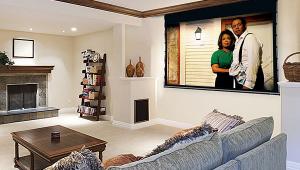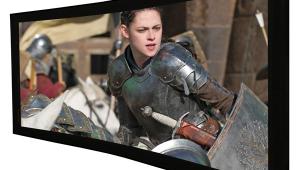Thanks for sharing! The Stewart Filmscreen Harmony G2 seems like a top-notch choice for those seeking reference-level Acoustically Transparent screens with speakers behind.
Stewart Filmscreen Harmony G2 Acoustically Transparent Screen Review Test Bench
| Screen Target Point | White Point | Luminance (ft-L) |
| Center (L&R, 2° Avg.) | 0.312 / 0.329 | 16.25 |
| Center Left Side | 0.313 / 0.313 | 13.31 |
| Center Right Side | 0.311 / 0.334 | 13.35 |
| Center Top | 0.313 / 0.333 | 16.16 |
| Left Top | 0.313 / 0.334 | 13.23 |
| Right Top | 0.315 / 0.333 | 13.42 |
| Center Bottom | 0.313 / 0.333 | 15.58 |
| Left Bottom | 0.313 / 0.335 | 12.93 |
| Right Bottom | 0.312 / 0.335 | 13.14 |
| Center Left (from 35° Left) | 0.313 / 0.329 | 15.99 |
| Center Right (from 35° Right) | 0.312 / 0.330 | 16.12 |
For measurements, I used a Labsphere USRT-99 Spectralon Reflectance Target placed on a tripod directly in front of screen center. (Many screen manufacturers use Labsphere targets as a baseline parameter for a color-neutral, Lambertian reference with 99% reflectance at any measurable angle.)
My luminance target for Rec.709 is 16 ft-L, so I began my calibration and, when finished, the white point was 0.313/0.330, and light output 18.2 ft-L. My 2.4 gamma target was a nearly flat 2.4. Setting the Labsphere aside, I refocused the projector to the screen and ran a pre-calibration pass that would highlight differences, if any, between the reference reflectance target and the screen itself.
The white point clocked in at 0.311/0.330 as light output dipped to 11.935 ft-L—not unexpected for a woven screen, though the lamp remained in Eco. Gamma remained largely corrected, averaging 2.39, rising from 40 IRE and staying at near 2.0 through 100 IRE. Calibration improved gamma tracking, dropping the average to 0.836 with the largest error coming at 90 IRE and measuring 1.53. Light output dropped a very slight 0.269 ft-L.
Color gamut pre-calibration averaged 1.309 with red the leading error at 1.159. After calibration, the average dropped to 0.678, cyan becoming the biggest offender at 0.958. Using the Color Checker feature in Calman software from Portrait Displays, a measurement of 47 different hues, the averaged error was 1.1, with a maximum 3.2 on purplish blue. Blue flower and blue sky upped the average as both measured at 2.8. A slight blue push isn't unheard of with woven screens, but Stewart has managed to deliver a nearly spectrally flat surface based on measurements made with a very capable $2,999 Epson projector.
With the projector's Natural mode selected, the calibrated white point at center screen was 16.249 ft-L and 0.312/0.329. Points measured at the perimeter varied from 12.925 ft-L and 0.315/0.333 to 15.581 ft-L and 0.313/0.334. I don't attribute these slightly lower light measurements and deviations from the white point to the screen, but instead to fall off from the outer circumference of the projector lens and associated chromatic aberrations.
This data indicates how neutral Stewart's screen is. Spectralon is a "static" reference surface material. The screen becomes reference caliber with a compatible projector (and skilled calibrator). This affords another hat-tip to Epson, because if a $3K projector plus this screen, in the standard size of 96 by 54 inches for just above another $3K, can create an image only hundredths of a percent off from reference, that's a challenge unmet a decade ago in metrics approaching six figures left of decimal point.—MPH
- Log in or register to post comments


The digital landscape is rapidly transforming, and even our shopping experiences are not left untouched. Recently, more electronic stores have started to adopt new technologies, allowing customers to purchase electronics using cryptocurrencies. This innovative step forward is facilitated by devices such as crypto terminals, which are becoming increasingly prevalent in large retail outlets.
One such provider of these crypto terminals is Lunu. On their website, https://lunu.io/products they offer a range of products designed to integrate cryptocurrency payments into businesses. This integration allows customers who prefer using digital currencies like Bitcoin or Ethereum to easily make purchases in a way that's both secure and convenient. Major electronics retailers are beginning to implement these terminals, reflecting a broader acceptance of cryptocurrencies in everyday transactions. This move not only caters to tech-savvy shoppers but also positions these stores at the forefront of the fintech revolution.

When it comes to finding the best forex trading platform for beginners, simplicity and reliability are key. MetaTrader 4 (MT4) and MetaTrader 5 (MT5) often emerge as popular choices. These platforms offer intuitive interfaces, robust charting tools, and ample educational resources, making them ideal for newcomers to grasp the basics of forex trading. Additionally, features like demo accounts on MT4 and MT5 allow beginners to practice risk-free before diving into live trading. However, it's essential for beginners to explore different platforms, considering factors like user-friendliness and available support, to find the one that aligns best with their learning needs and trading goals.

Like the perfectly tuned strings of a grand piano, the Stewart Filmscreen Harmony G2 Acoustically Transparent Screen resonates precisely and clearly. Stewart Filmscreen has created this screen to harmonize easily with your home theater configuration, much as a skilled craftsman painstakingly carves every element of a musical instruments to perfection. The Harmony G2 delivers amazing visual performance while preserving the purity of music, much as the careful balance of a symphony. Like the body of a well made violin, its acoustically transparent cloth lets sound pass through with unmatched accuracy.

The rise of stablecoin regulation is forcing issuers to increase transparency about their reserves. Governments are pushing for stricter oversight, ensuring that stablecoins remain fully backed and reliable click here for
prop firm reviews.

Emirates ID Visa – Does Your Emirates ID Work for Travel? UAE visa stamps have been scrapped in Dubai, and Emirates IDs have replaced them.

Application fee via typing centre: AED 70 | Via eForm: AED 40. You must submit the fees along with the application form for a lost Emirates ID replacement.

Emirates ID Number – Where to Find Your UAE Emirates ID Number? Emirates ID cards serve as proof of residency for all residents and citizens of the UAE
